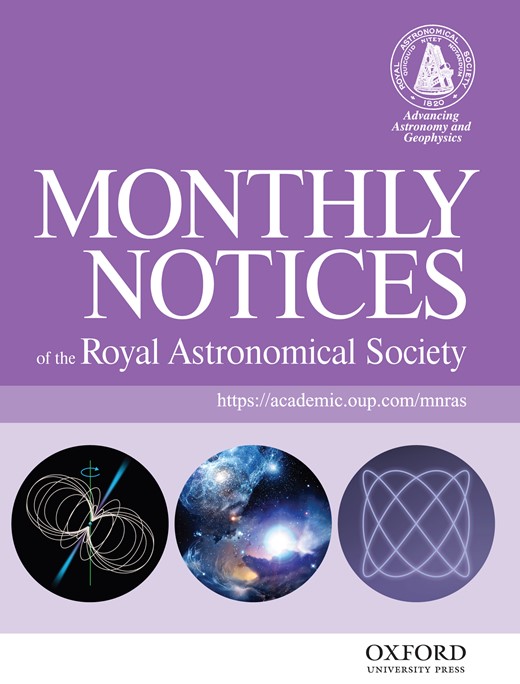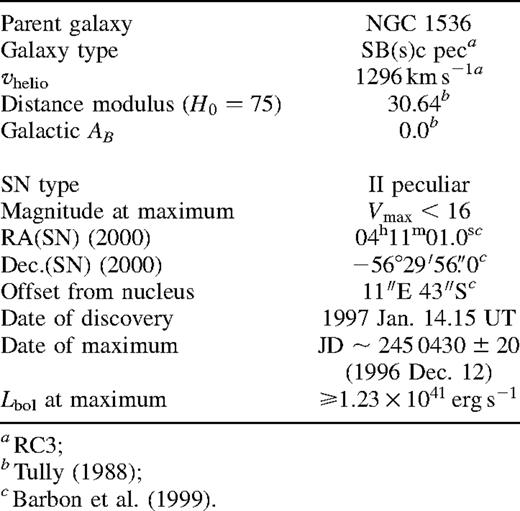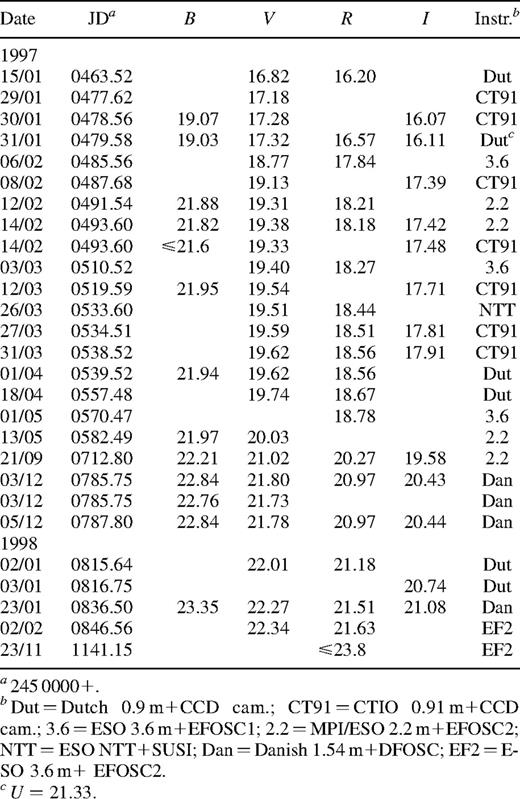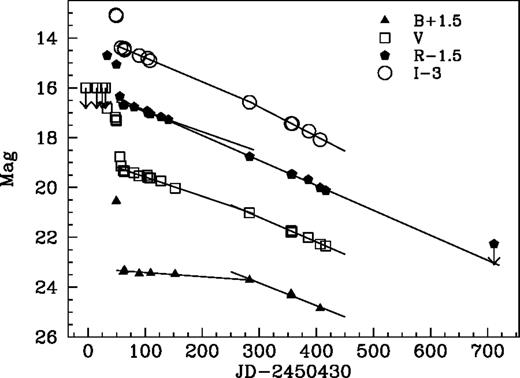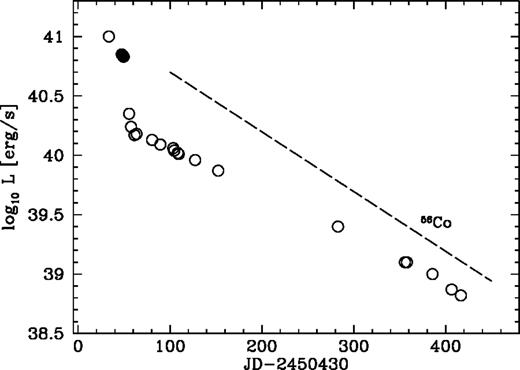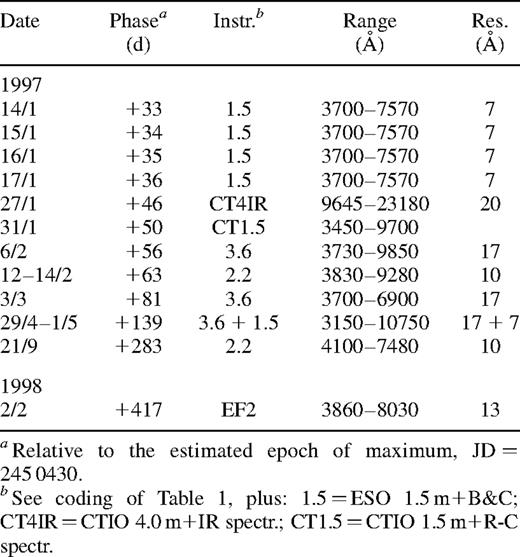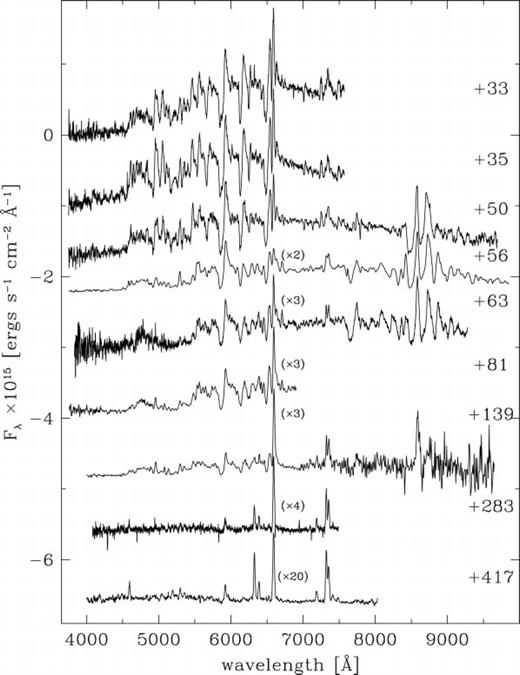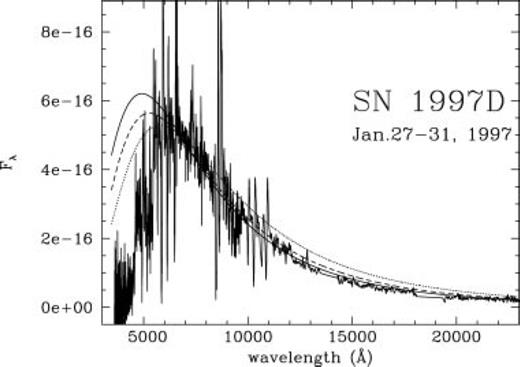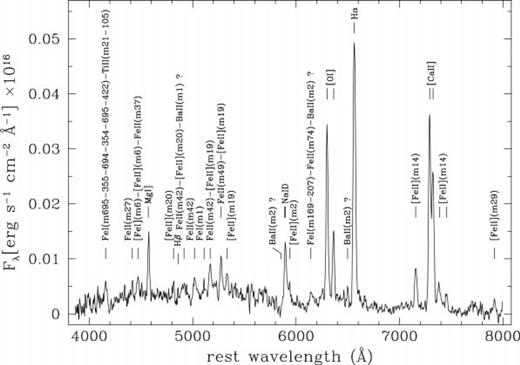-
PDF
- Split View
-
Views
-
Cite
Cite
S. Benetti, M. Turatto, S. Balberg, L. Zampieri, S. L. Shapiro, E. Cappellaro, K. Nomoto, T. Nakamura, P. A. Mazzali, F. Patat, The fading of supernova 1997D, Monthly Notices of the Royal Astronomical Society, Volume 322, Issue 2, April 2001, Pages 361–368, https://doi.org/10.1046/j.1365-8711.2001.04122.x
Close - Share Icon Share
Abstract
We present a new set of spectroscopic and photometric data extending the observations of SN 1997D to over 400 d after the explosion. These observations confirm the peculiar properties of SN 1997D, such as the very low abundance of 56Co (0.002 M⊙) and the low expansion velocity of the ejecta (∼1000 km s−1). We discuss the implications of these observations for the character of the progenitor and the nature of the remnant, showing that a Crab-like pulsar or an accreting neutron star formed in the explosion of a low-mass progenitor should already have produced a detectable luminosity at this epoch, in contrast with photometric data. On the other hand, the explosion of a high-mass progenitor with the formation of a black hole is consistent with the available observations. The consequences of this conclusion regarding the nature of the explosion and the prospects of directly identifying the black hole are also addressed.
1 Introduction
Supernova (SN) 1997D is the least luminous and least energetic Type II supernova discovered to date. An earlier analysis (Turatto et al. 1998, hereafter Paper I) showed that the SN peak magnitude was fainter than MV=−14.65, had a very red colour, indicating that the photospheric temperature at discovery was only Teff=6400K, and had very slow expansion velocities of the order of 1000 km s−1. The luminosity in the late light curve indicated that the ejected 56Ni mass was only 0.002 M⊙, at least one order of magnitude smaller than the estimates for normal Type II supernova (SNII).
A similar small amount of 56Ni was suggested for another Type II supernova, SN 1994W (Sollerman, Cumming & Lundqvist 1998). However, Sollerman et al. (1998) argue that the light curve of SN 1994W is contaminated in different phases by the probable contribution of circum-stellar matter—ejecta interaction and by dust formation in the ejecta, which makes this case less compelling than that of SN 1997D.
The unusual properties make SN 1997D an intriguing target for further study, especially with regard to the character of the progenitor and the nature of the compact remnant left after the explosion. In the following we will discuss two extreme alternatives: a high-mass (25–40 M⊙) star in which the low mass of 56Ni is the result of the fallback of material on to the collapsed core (Woosley & Weaver 1995); or a low-mass (8–10 M⊙) star in which hardly any 56Ni is produced to begin with (Nomoto et al. 1982; Nomoto 1984, 1987). In Paper I, based on modelling of the light curve and spectrum, we favoured a scenario in which a high-mass (26 M⊙) progenitor exploded about 50 d before the discovery with an explosion energy of only 4×1050 erg. Instead, Chugai & Utrobin (2000), using a hydrodynamical model and an analysis of the nebular spectrum, suggested that a low-mass progenitor (and a low explosion energy) is preferred. Identifying which of the two scenarios lies behind SN 1997D is of significant interest, as well as being an observational challenge. In particular, there would be several intriguing consequences if the progenitor was indeed a high-mass star, which would indicate the existence of a novel subclass of low-energy SNII.
Crucial to our discussion is the fact that the two scenarios differ qualitatively with regard to the nature of the compact remnant they produce. In the case of a low-mass progenitor, the likely remnant is a neutron star (Nomoto et al. 1982), while for a high-mass progenitor the rate of early fallback during the explosion is expected to induce the collapse of the proto-neutron star into a black hole (Colgate 1971; Chevalier 1989; Woosley & Weaver 1995; Woosley & Timmes 1996; Fryer 1999). The supernova birth of a black hole has recently found an important indirect observational proof from the detection of an overabundance of α elements in the atmosphere of the companion star orbiting a probable black hole in the X-ray binary system GRO J1655–40 (Israelian et al. 1999).
A direct observation of the effect of the newly formed black hole on the light curve is usually impossible, owing to the large abundance of radioactive isotopes. Zampieri et al. (1998b) found that, if SN 1987A had produced a black hole, it would emerge as late as 900 yr after the explosion at a luminosity of ∼1032 erg s−1. In the case of SN 1997D, Zampieri, Shapiro & Colpi (1998a) pointed out that, because of the very low absolute magnitude due to the low abundance of radioactive isotopes in the ejecta, the contribution by late-time accretion of material on to the black hole could emerge above the radioactive decay about three years after the explosion. Since this luminosity is expected to have a characteristic decay in time of t−25/18 (rather than the exponential decline typical of radioactive sources), it should leave a distinguishable imprint in the late-time light curve. This estimate was recently confirmed by a detailed investigation by Balberg, Zampieri & Shapiro (2000), who found that the luminosity at emergence should be 0.5−3×1036 ergs−1. Such a luminosity, at the distance of SN 1997D, is marginally detectable with HST, so, in principle, SN 1997D could offer a first direct observation of a black hole in a supernova.
In this work, we revisit the unusual character of SN 1997D and present the full set of photometric and spectroscopic data up to about 400 d after the explosion. In Section 3 we discuss the decline of the late-time light curve in connection with the nature of the progenitor of SN 1997D and its compact remnant, and show that the presence of a black hole is consistent with the available data. We present our conclusions and discuss several implications that arise from them in Section 4. In particular, we emphasize the importance of extending the observations of SN 1997D to the detection limit of the available ground- and space-based instruments.
2 The available data set
2.1 Photometry
The main data relative to SN 1997D and to the parent galaxy are summarized in Table 1 (cf. Paper I).
All the photometric measurements available to date are listed in Table 2. Observations were obtained on 27 different epochs up to about 400 d after explosion. Data reduction followed the standard procedures making use for the SN measurements of a point spread function (PSF) fitting technique. The mean photometric errors, estimated with artificial stars experiments, are about 0.05 mag when the SN was brighter than ∼19.5 mag, 0.10 mag for magnitudes ranging between 19.5 and 21, and 0.2 mag for the faintest magnitudes.
The B, V, R and I light curves of SN 1997D are shown in Fig. 1. On the basis of the light-curve modelling, in Paper I we argued that the maximum occurred around JD 245 0430 (±20 d) and that the SN has been caught at the end of the plateau phase on the way to reaching the radioactive tail. With the new data the late-time light curve appears to show two distinct behaviours: from day 70 to about 200 the decline rate γ is much steeper at red wavelengths than at blue ones [γB=0.16 mag (100 d)−1, γV=0.78 mag (100 d)−1, γR=0.80 mag (100 d)−1 and γI=0.96 mag (100 d)−1], while after day ∼200 the slopes are similar to each other [γB=0.91 mag (100 d)−1, γV=0.99 mag (100 d)−1, γR=1.00 mag (100 d)−1 and γI=1.18 mag (100 d)−1] and remarkably close to that of 56Co [γ=0.98 mag (100 d)−1].
B, V, R and I light curves of SN 1997D. Three of the prediscovery upper limits reported in Paper I are shown.
We used the multicolour photometry to estimate the bolometric light curve shown in Fig. 2. This has been obtained by integrating the flux in the BVRI bands, and then scaling up the curve to match the spectrophotometric observation of January 27–31 (filled symbol in Fig. 2) spanning the range 0.35 to 2.5 μm. This means that we made the assumption that the infrared (IR) contribution to the total luminosity remains constant at later epochs, consistent with the finding of Schmidt (2001). We note that most of the flux is emitted in the V, R and I bands and that, owing to the slow decline, the contribution of the B band becomes significant only after 250 d. Looking in more detail we find that the decline of the bolometric luminosity in the period 60–200 d, 0.89α0.02 mag (100 d)−1, is marginally slower and instead, after day 200, γbol=1.07α0.03 mag (100 d)−1, is slightly higher than that expected if the energy is supplied by the decay of 56Co.
Bolometric light curve of SN 1997D. The filled circle includes all the flux between 0.35 and 2.5 μm. Open circles represent the BVRI flux scaled to match the filled circle at the common epoch. The 56Co decay line is also reported for comparison.
The ratio of the bolometric luminosities of the last segment of the light curve with the corresponding one of SN 1987A is L(87A)/L(97D)=32.5, somewhat smaller than the value derived early on (Paper I). Assuming for SN 1997D the same γ deposition as in SN 1987A, we confirm our earlier suggestion that the mass of ejected 56Ni is about 0.002 M⊙.
2.2 Spectroscopy
The journal of the spectroscopic observations is given in Table 3. Fig. 3 illustrates the spectroscopic evolution of SN 1997D for over 1 yr after discovery.
Spectral evolution of SN 1997D. Wavelength is in the observer rest frame. The ordinate refers to the first spectrum (+33 d), the other spectra are shifted downwards by 1×10−15, 1.7×10−15, 2×10−15, 3×10−15, 3.9×10−15, 4.2×10−15, 5.6×10−15 and 6.6×10−15, respectively. For clarity some spectra have been multiplied by the factors given in parentheses.
The photospheric spectra are dominated by a red continuum and P-Cygni profiles of H i, Ba ii, Ca ii, Na i and Sc ii (see fig. 4 of Paper I). Spectral modelling showed that the unusual strength of the Ba ii lines compared with typical SNII is due to the low temperature rather than to overabundance. However, the most striking property of these spectra is the very low expansion velocity of the ejecta. The minima of the absorption lines give an expansion velocity of about 1100–1200 km s−1 for Hα and somewhat larger (1500–1800kms−1) for Ba ii. Spectral modelling suggests photospheric velocities between 900 (Chugai & Utrobin 2000) and 970 km s−1 (Paper I) and kinetic energies between 1 and 4×1050 erg, depending on the ejected mass. The spectral energy distribution in the optical—IR about 50 d past discovery is shown in Fig. 4. As mentioned above, the distribution is peaked in the optical window and very little flux is emitted at wavelengths smaller than 5000 Å.
Spectral energy distribution between 3500 Å and 2.3 μm. The energy distributions of a blackbody of 5900, 5500 and 5000 K are plotted for reference as continuous, dashed and dotted lines, respectively. The IR spectrum is from Clocchiatti et al. (2001).
Two months later the Hα emission starts to dominate over the Ba ii 6497 Å line and becomes the more intense spectral line along with Na i D and Ca ii IR lines. Starting 283 d past maximum the spectrum is that of a typical SNII in the nebular phase but for the very low kinetic energy.
2.3 Nebular line identifications
The low expansion velocity of the ejecta of SN 1997D offers a unique opportunity to resolve and identify spectral lines. These identifications are presented in Fig. 5 for the spectrum at +417 d.
Line identifications on +417-d spectrum. The wavelength is in the parent galaxy rest frame.
The strongest feature after the prominent Hα is the 7300 Å doublet. Because of the close wavelength coincidence we associate this emission with the [Ca ii] lines 7291–7323 Å and definitely exclude the contribution of [O ii] 7320–7330 Å doublet. We recall that the latter was instead identified in the late (about 15 yr) spectra of SNe 1979C and 1980K (Fesen et al. 1999). Just blueward of this feature an unblended emission is identified with [Fe ii] 7155 Å. Though sometimes questioned, this line was already identified in other SNII at late epochs (e.g. 1988A and 1988H, Turatto et al. 1993). Here for the first time we single out two other strong lines of the same [Fe ii] multiplet 14 (λλ7388 and 7453), confirming this identification. Many other lines of [Fe ii] and Fe ii are identified in the spectrum. In particular, several lines of the Fe ii multiplet 42 and the [Fe ii] multiplet 19 are clearly visible.
Another strong line is the emission due to [Mg i] 4571 Å. In contrast, Hβ is very faint if present at all, making the Balmer decrement  , which indicates collisional excitation.
, which indicates collisional excitation.
We could not find an unambiguous identification for a faint line measured at 6499 Å (rest frame). For continuity with the photospheric spectra, we tentatively identify this line with Ba ii 6497 (multiplet 2). To support this identification, we searched the spectrum for other Ba ii lines. It turns out that the strongest features (multiplets 1 and 2), if present, would be blended with intense iron emissions, and therefore we cannot make any definite statement.
More interesting is to analyse in detail the evolution of the [O i] 6300–6364 Å doublet. Spyromilio & Pinto (1991) have shown how it is possible to derive an estimate of the O i density from the evolution of the intensity ratio of the two lines, which ranges from 6300/6364=0.95 when the nebula is optically thick to 3.06 when the nebula is optically thin. In the three nebular spectra of SN 1997D, we measure 6300/6364=0.9α0.2 at +139 d, 1.9α0.1 at +283 d and 2.65α0.05 at +417 d. Following Spyromilio & Pinto (1991) we can estimate the oxygen number density at day +283 of 1.5α0.3×109 cm−3. Noting that the full width at half-maximum (FWHM) of the lines (corrected for instrumental resolution) is 680 km s−1 and assuming a uniform distribution, we estimate that the oxygen mass in the ejecta is ∼1 M⊙. If the filling factor is less than unity (Spyromilio & Pinto 1991 estimate a filling factor of ∼0.1 for SN 1987A), the oxygen mass may be even lower. Such an estimate seems more compatible with a low-mass progenitor (see Chugai & Utrobin 2000) than with a high-mass one, where the total mass of ejected oxygen is likely to be closer to 2 M⊙ (Balberg et al. 2000), but the latter cannot be ruled out in view of the large observational uncertainties involved in estimating the oxygen mass. Furthermore, the amount of oxygen left in the expanding envelope in the high-mass progenitor case is also sensitive to the extent of fallback on to the nascent black hole, so a low mass of ejected oxygen does not necessarily reflect the amount of oxygen in the progenitor.
3 The Nature of the Progenitor and the Compact Remnant
In principle, the low luminosity of SN 1997D may be due to either a low 56Ni mass or a low opacity to the γ-rays from radioactive decay. The fact that, for almost one year, the decline rate of the late-time light curve of SN 1997D matches the decay rate of 56Co is a strong indication that the envelope remains thick to γ-rays and hence that the ejected 56Ni mass is very low (0.002 M⊙). To date this is the lowest measured value of the 56Ni mass ejected in a supernova. The very low expansion velocity of the ejecta and the low explosion energy of a few 1050 erg are confirmed by the spectrum taken 1.5 yr after the burst.
These observations single out SN 1997D as an extremely unusual Type II supernova. As mentioned in the introduction, there are two distinct types of progenitors that can produce such an explosion — either a relatively high-mass star (26 M⊙; Paper I) or a relatively low-mass one (8–10 M⊙; Chugai & Utrobin 2000). The two models differ in their prediction regarding the nature of the compact remnant. For the massive star model, significant fallback of matter is expected because of the very low explosion energy and the deep gravitational potential of such a massive star. In contrast, for the 8–12 M⊙ model, the mantle of heavy elements and the surrounding He/H envelope are so extended that fallback is very small, even for explosions as weak as ∼1049 erg (Nomoto et al. 1982; Nomoto 1984, 1987; Nomoto & Hashimoto 1988). The significant amount of fallback in the high-mass progenitor will most likely produce a black hole, while in the low-mass scenario fallback is negligible and a neutron star is probably formed. As suggested by Zampieri et al. (1998a) and recently supported by Balberg et al. (2000), this distinction is of special interest in the case of SN 1997D and in the high-mass progenitor scenario, since it may offer the first opportunity of a direct observation of a newly formed black hole in a supernova remnant.
3.1 Light curve and spectral simulations
We performed theoretical calculations of the late-time light curve of SN 1997D for both high-mass and low-mass progenitor models. The mass of the ejecta and the explosion energy of the high-mass progenitor model (constructed from the 25-M⊙ model of Umeda, Nomoto & Nakamura 2000) are Mej = 18 M⊙ and E=4×1050 erg. The low-mass model has Mej = 6 M⊙ and E=1×1050 erg, as adopted by Chugai & Utrobin (2000). All the calculations were performed with a spherically symmetric radiative transfer code, which solves a γ-ray transfer equation with one-energy group approximation as well as a photon transfer equation (Iwamoto et al. 2000).
In both models, 56Ni is distributed uniformly up to an expansion velocity of 800 km s−1, as suggested by the spectral analysis (Paper I). We find that, in the high- and low-mass progenitor models, 99 per cent and 94 per cent, respectively, of the γ-rays are trapped at day ∼400, and thus the optical light curves decline at a rate close to that of 56Co, consistent with observations. At day ∼400, the difference between the two models is too small to be detectable (the high-mass model is only 5 per cent more luminous than the low-mass model). Significant deviations from the 56Co decay rate and differences between the two models (∼0.2 mag) are predicted to be seen only after day ∼800.
Models suggest that after the end of the plateau, which is the consequence of an inward-moving recombination wave in the H envelope, the light curve of a SNII should be determined mostly by γ-ray deposition followed by immediate radiation of optical photons. Therefore the 56Co rate should be a lower limit to the slope of the light curve. However, observations covering the period 60–200 d show that the decline rate was slightly slower than the 56Co decay rate. This suggest that γ-ray deposition followed by instantaneous emission of optical photons might not be the only source of luminosity for SN 1997D at this epoch. This probably means that the photosphere has not disappeared yet. Indeed, spectra taken at 81 d and 139 d (Fig. 3) show the persistence of P-Cygni absorption profiles in many of the strongest lines (Na i D, Ba ii, Hα), even though the Ca ii IR triplet is dominated by emission. Note also that the emission component in Hα is much stronger than the absorption component, while they are equivalent in Na i D. Although the contribution of net emission is significant, a thermal continuum might still influence the spectral shape. In addition we find that the B band, where there are no strong emission lines, declines much more slowly than the redder bands, all of which include some strong emission lines.
The presence of a photosphere at such advanced phases (its velocity, as measured from the P-Cygni profile of Hα, is ∼1090 km s−1) might suggest the presence of an inner region with a steep density gradient, situated below the H envelope. This fact might favour a high-mass model and deserves further quantitative study. The spectra taken at late times (283 d and 417 d) show only emission lines and, in that period, the light-curve decline rate becomes closer to the 56Co decay.
We tried to simulate the nebular spectrum of SN 1997D using a non-local thermodynamic equilibrium (NLTE) spectrum synthesis code that computes γ-ray deposition and heating, followed by cooling by forbidden line emission. The code is designed for Type Ia SNe, so H is not included. Fitting the observed Fe ii forbidden lines provides support to the finding that the Ni mass is of the order of 0.002 M⊙. Also, the velocity of the nebular lines is very small, about 800 km s−1, confirming that the kinetic energy of the ejecta is low and that the small Ni mass is not mixed out significantly.
3.2 Black hole remnant
We now turn to discuss the implications of the late-time measurements on identifying the nature of the compact remnant. The data indicate that the late-time bolometric light curve is consistent with the decay of 56Co, and there is no evidence up to 400 d of a change in the decline rate caused by emission from the newly formed compact object. The bolometric luminosity at t=417d is 7.8×1038 erg s−1 sufficiently low that emission from a solar-mass compact object accreting at the Eddington limit (LEdd≈2.6×1038M*ergs−1, where M* is the mass of the compact object in M⊙ and the accreting material is assumed to be hydrogen-poor) should have already been detected through a deviation from a perfect 56Co decay. Furthermore, the upper limit in the R band at ∼700 d rules out emission at a luminosity level of ∼1038 erg s−1 from the compact object at that time, and further strengthens the conclusion that Eddington-limited accretion is not taking place. Therefore, quite independently of detailed theoretical modelling, these observations in themselves tend to favour the black hole formation scenario.

We note that, if the bound material has sufficient angular momentum, accretion should proceed via a disc, rather than through a spherical inflow. The disc would have to be very optically thick and advection-dominated in order to accommodate the hypercritical accretion rates expected during the first years after the explosion [see Mineshige et al. (1997) for a hydrodynamic study of the properties of such discs up to ∼1 d after the explosion]. While the emission properties of such advection-dominated, optically thick discs at hypercritical accretion rates are poorly understood at present, disc accretion on to a black hole can, in principle, also be consistent with the current observations if the accretion efficiency is low.
3.3 Neutron star remnant
The possibility that the remnant of SN 1997D is a neutron star can be examined in a similar fashion as the well-studied case of SN 1987A. To date, the SN 1987A remnant has failed to provide any evidence for the presence of a neutron star formed in the explosion.
First, we note that the luminosity at t=417d appears to rule out the formation of a Crab-like pulsar in SN 1997D. The present magnetic dipole emission estimated for the Crab pulsar is ∼5×1038 ergs−1, and at an age of 417 d it was probably ∼1040 erg s−1 (Kumagai et al. 1989; Woosley, Pinto & Hartmann 1989). If a sizeable fraction of such emission is deposited in the supernova ejecta, it should have had an observable effect on the luminosity.
If SN 1997D did produce a neutron star that is weakly magnetized and/or slowly rotating, this may have been observable if it is accreting material through late-time fallback. Initially, the accretion rate is so high that such fallback is expected to be neutrino-cooled and to produce very little observable radiative luminosity, but this luminosity should gradually increase as the expansion of the ejecta causes a decline of the accretion rate (Chevalier 1989).

 is related to the kinetic energy per unit mass ℰ and the amount of mass Mbound that is gravitationally bound to the neutron star at the onset of homologous expansion:
is related to the kinetic energy per unit mass ℰ and the amount of mass Mbound that is gravitationally bound to the neutron star at the onset of homologous expansion: 
 in equation (2), we find that the Eddington-limited accretion phase is reached at time
in equation (2), we find that the Eddington-limited accretion phase is reached at time 
Unlike typical Type II supernovae, which have a larger 56Co abundance, in SN 1997D this abundance is so low that the radioactive luminosity is comparable to the Eddington limit for a solar-mass compact object as early as a few hundred days after the explosion. Hence, in SN 1997D, t∗ provides a reasonable estimate as to when the fallback luminosity will ‘emerge’ above the emission of radioactive elements, causing the light curve to deviate from pure 56Co decay.

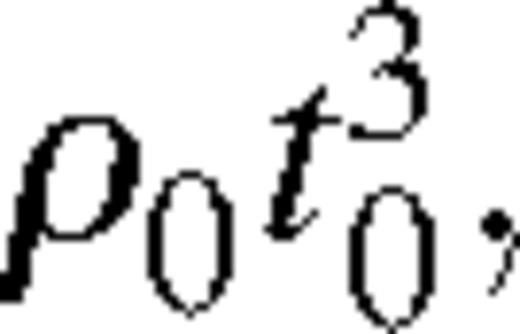 i.e. with decreasing explosion (and kinetic) energy. This small amount of gas is dynamically negligible if compared to the mass of the neutron star. However, as shown by equation (2), it is sufficient to establish a considerable accretion rate at late times (∼10−4 M⊙ yr−1 at t∼1 yr) and to give rise to an Eddington-limited luminosity ∼1 yr after the explosion (equation 3).
i.e. with decreasing explosion (and kinetic) energy. This small amount of gas is dynamically negligible if compared to the mass of the neutron star. However, as shown by equation (2), it is sufficient to establish a considerable accretion rate at late times (∼10−4 M⊙ yr−1 at t∼1 yr) and to give rise to an Eddington-limited luminosity ∼1 yr after the explosion (equation 3).The post-explosion profile of the bound material in the 26-M⊙ progenitor model of Paper I has  , for which the accretion rate would decline to 4×10−4 M⊙ yr−1 only at ∼2.5 yr after the explosion. Although this model involves forming a compact remnant with a mass
, for which the accretion rate would decline to 4×10−4 M⊙ yr−1 only at ∼2.5 yr after the explosion. Although this model involves forming a compact remnant with a mass  and therefore likely to be a black hole, its parameters do allow for an accreting neutron star to remain hidden in its midst for up to t=900d. On the other hand, the corresponding parameters for the low-mass progenitor of Chugai & Utrobin (2000), which is much more likely to have produced a neutron star, give
and therefore likely to be a black hole, its parameters do allow for an accreting neutron star to remain hidden in its midst for up to t=900d. On the other hand, the corresponding parameters for the low-mass progenitor of Chugai & Utrobin (2000), which is much more likely to have produced a neutron star, give  . This latter case is more similar to that of SN 1987A, and accretion on to the neutron star will have reached the critical rate 4–5 months after the explosion, and at t=417d would be radiating at the Eddington luminosity. The absence of such luminosity in the light curve of SN 1997D at 400 and 700 d could imply that the remnant is a black hole.
. This latter case is more similar to that of SN 1987A, and accretion on to the neutron star will have reached the critical rate 4–5 months after the explosion, and at t=417d would be radiating at the Eddington luminosity. The absence of such luminosity in the light curve of SN 1997D at 400 and 700 d could imply that the remnant is a black hole.
Note, however, that the same reservations originally raised regarding SN 1987A apply here as well. First, accretion luminosity would not be produced if the accretion flow is disrupted as a result of dynamical instabilities. Fryer, Colgate & Pinto (1999) have recently speculated that such an instability could arise for an accreting neutron star when the heavier elements begin to recombine, giving rise to a line-driven wind that eventually expels all the material that was initially bound. Furthermore, as noted by Mineshige, Nomoto & Shigeyama (1993), if an accretion disc forms, the time-scale for the accretion luminosity to decrease below the Eddington limit depends on the viscosity parameter, and further study is needed to investigate the evolution in this case.
4 Discussion and conclusions
The analysis of the late-time photometric and spectroscopic data presented here highlights the peculiar character and unusual properties of SN 1997D. The very low expansion velocity of the ejecta (∼1000 km s−1) and the very low abundance of 56Ni (0.002 M⊙) make SN 1997D a unique supernova. The observations made until 400 d after the explosion (and an upper limit of the luminosity at 700 d) lend further support to the interpretation that this supernova was the result of an unusually low-energy explosion (∼1050 erg). The available spectroscopic data show also that at t=417d the supernova ejecta have not yet started to interact with the circumstellar matter.
The observed light curve of SN 1997D after day 300 is consistent with pure radioactive heating, and there is no evidence of a significant deviation caused by other energy sources in the expanding supernova envelope. A neutron star formed from the collapse of a low-mass progenitor would have produced emission at the Eddington rate if it were rapidly rotating and strongly magnetized (like the Crab), or if it were slowly rotating, weakly magnetized and accreting due to late-time fallback. Such emission would have caused the light curve to deviate from pure radioactive heating decay by t=417d. Therefore, the presence of a neutron star remnant seems less likely. On the other hand, a spherically accreting black hole is indeed expected to be undetectable in comparison to radioactive heating during the period of observation, and hence it could not have revealed its presence (a black hole accreting hypercritically through a disc could also be undetectable if the accretion flow is advection-dominated). The formation of a black hole remnant is thus consistent with the available data.
Several interesting implications can be drawn from the conclusion that a black hole may be present in SN 1997D. First, the large amount of fallback needed to produce a remnant of ∼3 M⊙ would imply that the progenitor was a massive star. In this respect, it is interesting to investigate how the explosion energy of a massive star could be reduced to only a few 1050 erg. We note that Iwamoto et al. (2000) proposed a scenario in which the core of SN 1997D had a small angular momentum because the angular momentum of the core was transferred via magnetic field interaction to the massive H envelope. In this scenario the explosion of SN 1997D took place as a low-energy SNII instead of as a hypernova as in the cases of SN 1998bw and SN 1997ef, which had similar masses. Furthermore, if such low-energy supernova have a non-negligible rate (but are only underdetected), they could have a significant influence on the formation rate and mass distribution of compact objects, and perhaps even on nucleosynthesis abundances of heavier elements.
Most notably, if the remnant is a black hole, SN 1997D may be the first case where obtaining direct observational evidence of the emergence of a black hole in the light curve is technologically possible. Such an observation would confirm the theoretical assessment that black holes are formed in supernovae (Timmes, Woosley & Weaver 1996; Fryer 1999). As mentioned above, in the case of SN 1997D, the luminosity due to late-time spherical accretion on to the black hole may thus be observable about 3 yr after the explosion (Zampieri et al. 1998a; Balberg et al. 2000). The specific power-law time dependence of this luminosity should allow one to distinguish it from any radioactive source and also from any possible emission caused by circumstellar interaction (which in any case has not been observed as late as 1.5 yr after the explosion). We therefore re-emphasize the need for obtaining deep observations of SN 1997D in the very near future.
We will focus our attention also on a more recent supernova, SN 1999eu, which shows many similarities with SN 1997D and for which we hope to be able to secure very late photometric and spectroscopic observations.
Acknowledgments
The work reported in this paper is based on observations collected at ESO—La Silla (Chile). I. J. Danziger is acknowledged for helpful suggestions and discussions.
This work has been supported in part by the Italian Ministry for University and Scientific Research (MURST) under grant cofin–98–2.11.03.07 at the University of Padova, by NSF grant AST 96-18524, and NASA grants NAG 5-7152 and NAG 5-8418 at the University of Illinois at Urbana—Champaign, and by the grant-in-Aid for Scientific Research (07CE2002, 12640233) of the Ministry of Education, Science, Culture and Sports of Japan.
References


